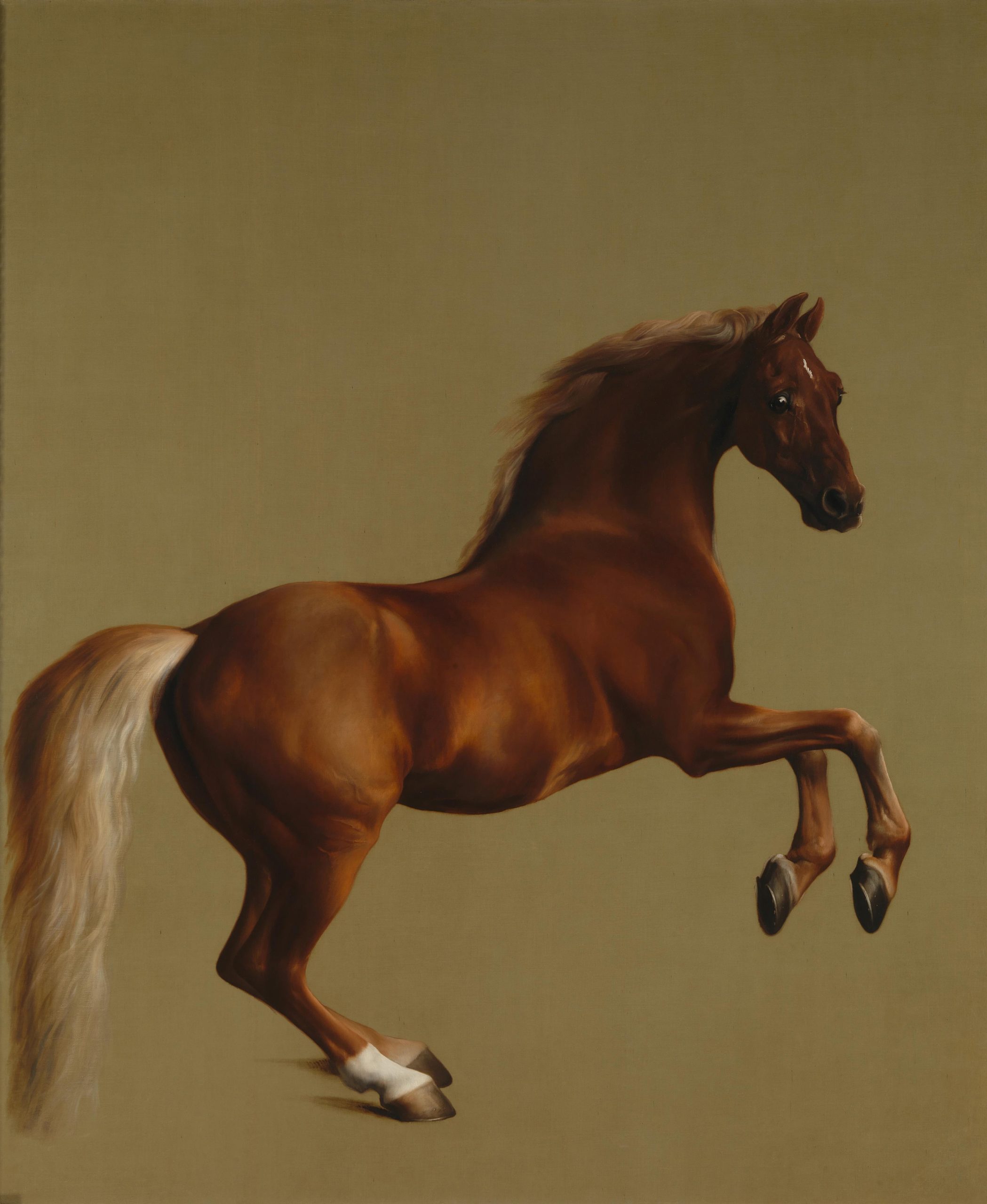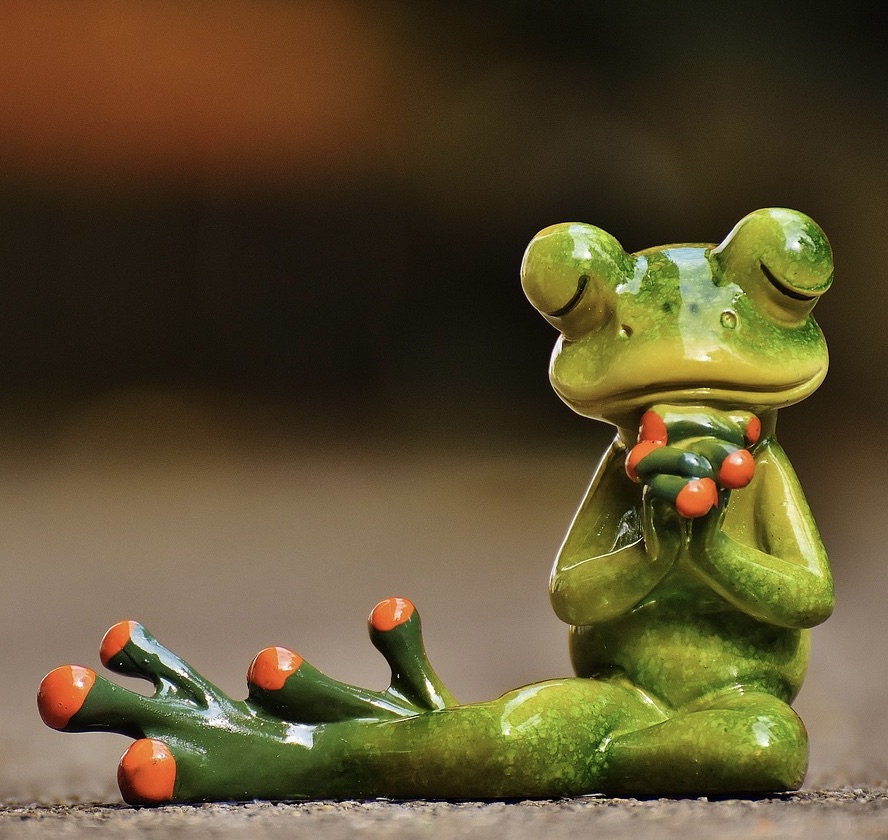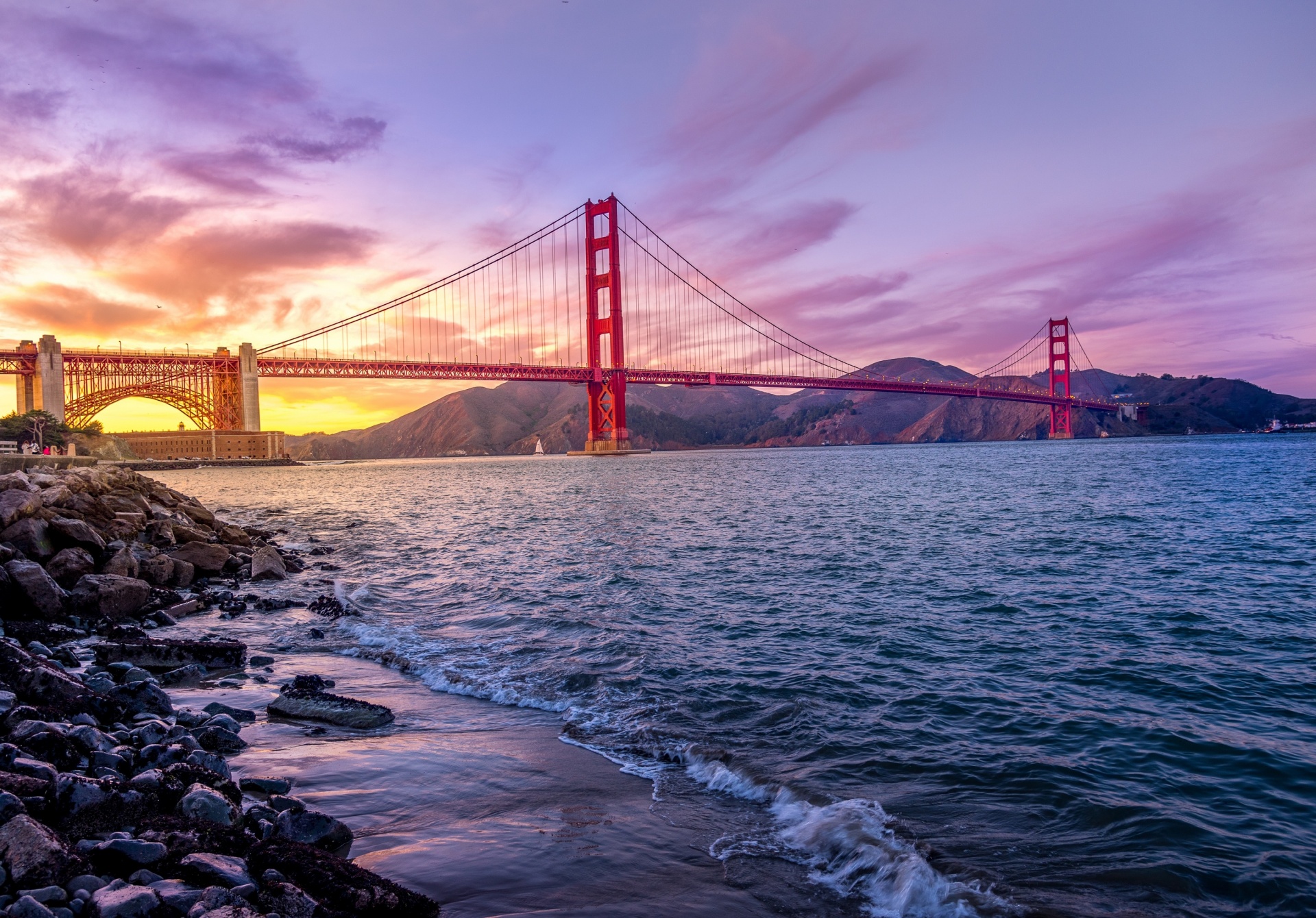I went with my books to the museum
to see the painting
my professor had assigned
because he feared,
he said, I’d grown too attached
to beauty, but the horse
was behind glass: the doors
to its gallery
locked–all the guards
that summer on strike–so only
parts of the painting
could be spied
through cracks: a corner
of canvas the color
of a martini olive glowing green,
then gold, then butterscotch
under the lights. What I saw
of the horse then
was what I knew already
from class: something
between silk and money, gilt
and rubbed brass–no sense
of the field in which it reared:
the actual thing my professor
wanted me to study: that nothingness
of green and gold
from which Whistlejacket rose,
the painting incomplete,
due to accident, or perhaps absence
was always the point:
there was never meant to be
a fence, a rider, an estate;
never meant to be
an artist, even: Stubbs
had erased humanity entirely
from his painting, my professor
said, rejecting it
as if the horse,
as subject, was not
also a particular part
of humanity: to see
a horse is to see
the grooms, stables, palaces
out of which its seed
was taken over oceans,
traded and bred. The horse
carries all things
inside it: it is the product
and not just the argument
of beauty, so everything
invisible in the painting
becomes present
to the mind, even
as my professor insisted
I did not need to see
these things to appreciate
the horse’s singularity
of line and shadow, which is all
the true artist really needs,
he said, not the fussy
more of context, ideology:
the mind must be greater
than bodies, politics, things
my professor hated
about Whistlejacket, even as he wanted me
to study it, to take apart
its genre if not its style. Portraiture
was a woman’s art,
he insisted, like still
life, landscape: the intimate
quotidian details
that only those cut off
from a larger world
would think to paint.
Even the way
Stubbs posed this horse
sentimentalized it,
its one eye fixed
upon the admiring
viewer, ears pricked
as he rears, balletic,
up. Imperious
as any general or king, which,
even as Stubbs stripped the human
pose of its self-
importance, reproduced
its attitudes, gestures:
a mimicry that,
in the end,
some part of me, too, felt
self-consciously simple.
But wasn’t the horse
always a symbol
of self-consciousness?
And how else to imagine power
but through flesh,
which, when made beautiful,
makes power
beautiful as well?
Weren’t certain artists,
I wondered to myself, required
to be less visible
than others, certain artists forced
to be pure spectacle, and
weren’t these often
the same artists?
I didn’t ask such questions
at twenty, dismayed
only by the possibility
that representation
was thoughtless
reproduction, bodies
generated out of bodies, one student
called it: the future
was abstraction,
which emptied the figurative
of its crass fidelity
to the “too pretty”
world, as my professor called
my sketches
of parents, lovers,
tossing aside these drawings
even as he called me
once into his office to ask
if I photographed
as good as I looked. “Too pretty”
is a charge one might lob
at Whistlejacket,
though of course
there is still
that emptiness, the widening field
highlighting both the horse
and its absence: Stubbs’
self-hatred enclosed
inside the little silver gleam
of a shoeing nail
shining from its hoof:
a reminder
of his father, perhaps: a farrier, a drunk
whose menial work
Stubbs despised
and so he turned
to midwifery anatomies instead,
drawing pictures of dead
pregnant women,
cutting into them
to teach himself
what every muscle
of both bodies looked like. Art
should not be classical
fabrication, Stubbs thought,
an early corollary
to my professor’s
argument, perhaps:
the classical being too
ornate and allusive
to be serious, as Stubbs
believed nature was art’s
truest subject. Nature alone
can teach us
everything, he said,
and so he moved
his son and common-law wife
to the country to draw horses
by suspending their corpses
in a barn,
injecting them with wax
then cutting them down
through layers of tissue
and fat to bone.
It takes 11 weeks
for a horse to rot; it takes years
to make a book
of their anatomical drawings
no engraver will publish, so costly
they are to reproduce, so useless
to any other artist
than Stubbs himself.
Unable to see Whistlejacket
in the National Gallery,
I went to the Royal Academy of Arts
instead to see
his archive, sketches of Arabians
with pleated manes Stubbs scratched
in graphite, grey and white flanks
rippling; each pale,
raised hoof veined
as a slice of cratered moon.
So much lavish,
microscopic detail
of neck and hide
I could see
some part of my own mania
reflected:
all my urge to describe and describe
gleamed within these sketches,
as if such details
would bring me closer
to what might be called
the truth. I have always
confused the painstaking
for intelligence. Always
the part for the whole.
I thought, for example,
if I could please
my professor, it meant
the world of art itself
would open up. All it meant
was a breath in my ear, a hand
strolling casually
down my back. Both of us
wanted to take me
out of the picture.
And now that I’m a professor
and artist myself, I admit
I’m bored
by the indifference
of that indiscretion: I hardly felt,
even then, offended
by it, merely embarrassed
to be so unbalanced
by this caricature
of a desire we both
flailed towards and
chafed against. But now
what am I to do
about beauty, about
my fear that beauty
has made me arrange
every experience in word
and image too neatly
for them to bear
much semblance to life:
my grasping,
vicious sex; my ambition;
all the little betrayals
that have followed after?
What has art been for me
but a desire to fit myself
into an illusion
that there’s recompense for the pain
of seeing
and being seen?
And doesn’t some part of me,
even now, agree with the professor’s
stark definitions
of excellence, which
I once found elegant
in their simplicity: the false
line demarcating greatness
from mediocrity? Haven’t I
sought out such authority
myself, haven’t such rules
pushed me
towards my own
creation, the point
of beauty being
not its pleasure but its increase
as I copied out the world
line by line, lulled
into an ecstasy
that resembled negation?
Why deny my attractions
unless they shame me
with their sheen
of the inauthentic I once sensed
in the postcards, notebooks, scarves
with Whistlejacket’s image
stamped on them, the shock of the horse
lessening each time I saw it
reproduced? The summer
I spent studying Whistlejacket
in London I was twenty, sick
with desire for a man
who would not touch me, eating
first too little, then too much;
I could barely speak,
could barely hold a pencil
in class. I dreamed
I might draw a world
this man wanted to enter
with me.
I dreamed I could become
art itself: was all this why
my professor chose Whistlejacket
for me to study, did he disdain
the horse because in it he recognized
my sex or my drawings,
or was it a punishment
to send me on an errand
I could never accomplish?
He must have known,
because of the strikes,
no one could see
the painting: it was a trick
to send me to the gallery
to stare at doors and glass, a slice
of gold, its hint
of nothing. Empty yourself,
he’d commanded,
cupping his hand
over my brush.
For years after that class,
I stopped drawing. I couldn’t
get past seeing my failure
with art, couldn’t
stop seeing more of Stubbs
emerge from his painting.
When I look at images
of Whistlejacket now, I see
human eyes staring, frightened,
out: a gaze
that seems to pierce
the veil between fact
and ideal, art
and surgery, the stallion
rearing from its perch of grainy light, caught
in a pose that can’t be held
except in memory.
It made me wonder
if Stubbs had ever even seen
this horse
or just drew, finally,
the souls of all the dead
pregnant women he’d dissected. Now
I suspect he’d hung
a horse from the rafters
of his barn: its metal hooks
tearing through flesh to duplicate
the pose, legs yanked
out and apart
as the long neck arches
so the dished-in face
could stare back
at its creator. Ghastly
to picture it: imagined
life contained
within a real corpse,
a body in a body that’s nothing
but architecture.
What did Stubbs think
about cutting up those women
but that some more
vivid truth might be found
bursting from time’s shadow:
death to life, death
as life, the painting assembled
from inert
material. Would I know
beauty at all if I did not know
death, stopped
on the street one afternoon
by a woman who asked,
Do you really know
how to appreciate your youth?
And what is the point
of me telling you all this anyway?
What more of me
or of Whistlejacket can you picture
after hearing it, all my little
fears and vanities smeared
across the canvas but in such
pretty colors they do not
offend; let me
polish this up, let me make it
a river of beaten gold in which
all stories, selves dissolve.
Once again, I have failed
at explaining myself.
I gave you a pretty horse
when what you wanted
was the field, the one
I sat at the borders of all summer
long, crouched
behind locked doors,
writing everything down
I could not see
about the painting,
until my notebooks filled
with doors and glass,
and the class ended,
and the essay
was turned in, the drawings
abandoned,
and the man I wanted
sailed off to Thailand, and only
these notebooks now remain detailing
how I never once
saw Whistlejacket,
never drew a single thing
so well it felt like a mind
ever in the act
of taking itself apart. Only one thing
more do I recall: the last day
I visited Whistlejacket, a man
and his girlfriend
stood beside me at the gallery’s
locked entrance, peering in, as I did,
at the painting’s fragments
until a beam
of sudden light fell on part
of the canvas, penetrating,
illuminating color, so that
the horse’s flank and backdrop both
appeared to open: the gold,
the red, the green,
the ochre
making the horse shudder
from its distance, disappear
into the field
and come alive again, shimmering
through the very slats
of the door behind which
we stood, where the young man
beside me turned
to his companion,
grimaced, and said, Well,
perhaps I find myself
holding back a bit
on that one, at which point
I wanted to kill him,
so astonished was I
at his disgust (Sketch
for horse-
mad girls, he called it, walking off), at what
he had mistaken
from his distance:
I saw at once the painting
was not meant for him;
it made me feel
for the first time the true
power of beauty:
not to attract but to repulse
those who would withhold
themselves from it, terrified
of being entered
by all they saw.
What did my desire
for beauty mean,
finally, but that I believed
I could survive it,
could expand
to become part of it:
it is not the loss
of consciousness but its
extension, the space
where you and I
meet and dissolve, meet
and pull apart:
the painting preserving
its own privacy by vanishing
before anyone
who refuses it. It made me tender
toward the horse, the field
that were always
the same thing
in the end, the particulars
of one blurred into the universal
possibilities of the other.
Anyone who was willing
could enter: the doors
to time’s knowledge
are always unlocked.
One body
open to the next, and the next:
the horse, the field
which has no precedent, where I
have entered the field.

Paisley Rekdal is the author of four books of nonfiction, and seven books of poetry, including Nightingale, Appropriate: A Provocation, and, most recently, West: A Translation, which was longlisted for the National Book Award and won the 2024 Kingsley Tufts Poetry Award. She is the editor and creator of the digital archive projects West, Mapping Literary Utah, and Mapping Salt Lake City. The former Utah poet laureate, she teaches at the University of Utah where she directs the American West Center.


![Monument for Inger Christensen. Photo by David Stjernholm. Featured image for [o] by Kristi Maxwell.](https://atlengthmag.com/wp-content/uploads/2025/06/Monument-for-Inger-Christensen_Kaare-Golles_002_Photo-by-David-Stjernholm-1280x914-1.jpg)
